This was the biggest game in Botafogo’s history.
At the end of a gruelling campaign that has seen them play 72 games, they found themselves on the brink of history.
They had reached the Copa Libertadores Final for the first time in their 120 years of existence.
They faced an Atlético Mineiro side who had most recently won the competition in 2013.
Ten days prior to this fixture, the two sides faced each other in domestic competition—a feisty affair that saw two red cards and a great deal of hostility.
As the passion of both sets of supporters filled the Estadio Monumental with an exhilarating atmosphere, emotions and tensions ran high.
They were too high for some.
In the opening 30 seconds, defensive midfielder Gregore made what could have been the mistake of his career.
His high foot hit Fausto Vera’s head, and he was sent off in the game’s first minute.
What was that?! The fastest red card in the Copa #Libertadores final. Botafogo’s Gregore with a criminal tackle on Fausto Vera.pic.twitter.com/mM8aqBj5Dt
— BabaGol (@BabaGol_) November 30, 2024
Yet, Botafogo weren’t going to let history pass them by.
An inspired performance combined with resilience, bravery, and individual quality led the Rio club to win South America’s most prized club competition.
A 3-1 victory saw pandemonium in the stands as Botafogo’s 10 men put in the performance of their lives.
This post-match analysis will analyse Alvinegro Carioca’s brilliance and highlight Atlético Mineiro’s lack of inspiration and composure.
Atlético Minero Vs Botafogo Lineups
Atlético Minero lined up in a 3-4-3 formation.
Everson started between the sticks.
In front of him was a back three of former Southampton defenders Lyanco, Rodrigo Battaglia, and Júnior Alonso.
The midfield four consisted of Gustavo Scarpa, Fausto Vera, Alan Franco, and Guilherme Arana.
The front three saw captain Hulk take his customary place on the right flank, Deyverson through the middle and former Bayer Leverkusen forward Paulinho on the left.
The Belo Horizonte club had come into the final in incredibly poor form.
They were 10 games without a win.
They hadn’t won a game since their 3-0 victory against River Plate in the first leg of the Copa Libertadores semi-final.
Botafogo lined up in a 4-2-3-1, with ‘keeper John starting in net.
Former Manchester United full-back Alex Tellas started as left-back alongside Ardyelson, Alexander Barboza, and Vitinho.
Marlon Freitas was partnered by the quickly dismissed Gregore in a double pivot.
An attacking quartet of Thiago Almada, Jefferson Savarino, former Real Betis winger Luis Henrique, and Brazilian international Igor Jesus provided a significant threat.
Artur Jorge‘s side has had a remarkable season, which sees them on the brink of winning Série A.Having comfortably bypassed Peñarol in the Semi-finals, Botafogo had to be considered the overwhelming favourite.
All form, game plans and pre-match predictions went out the window after Gregore’s red card.
So how did Botafogo achieve the miraculous?
Weathering The Storm
In the chaos of the sending-off, Botafogo had to react and prevent a difficult situation from worsening.
The first ten minutes saw a bombardment of initial attacks from Atlético Mineiro.
Botafogo remained compact and showed that they wouldn’t be easily beaten.
They did this by setting up often in a 5-3-1 or 6-3-0 formation.
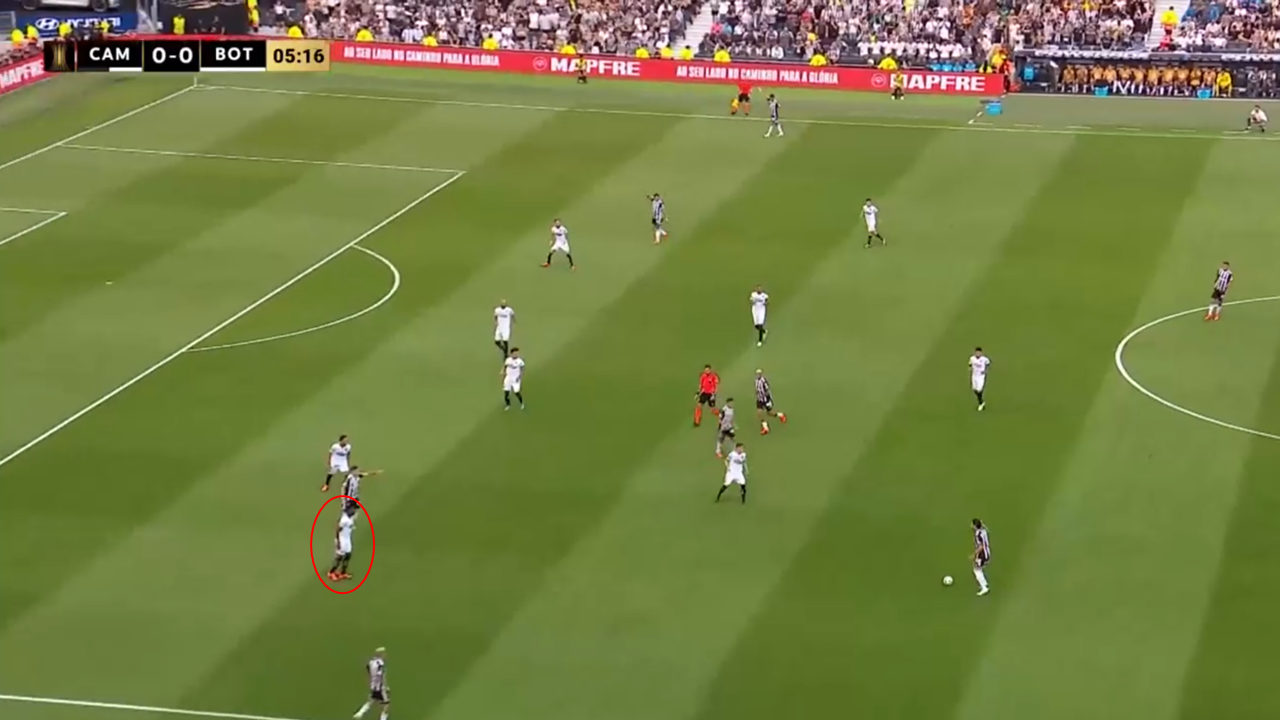
As seen here, as Atlético Mineiro looks to break down the opposition, they’re faced with their opponents’ incredibly low blocks.
Depending on which side was being attacked, either Luis Henrique or Almada would usually drop into the full-back position.
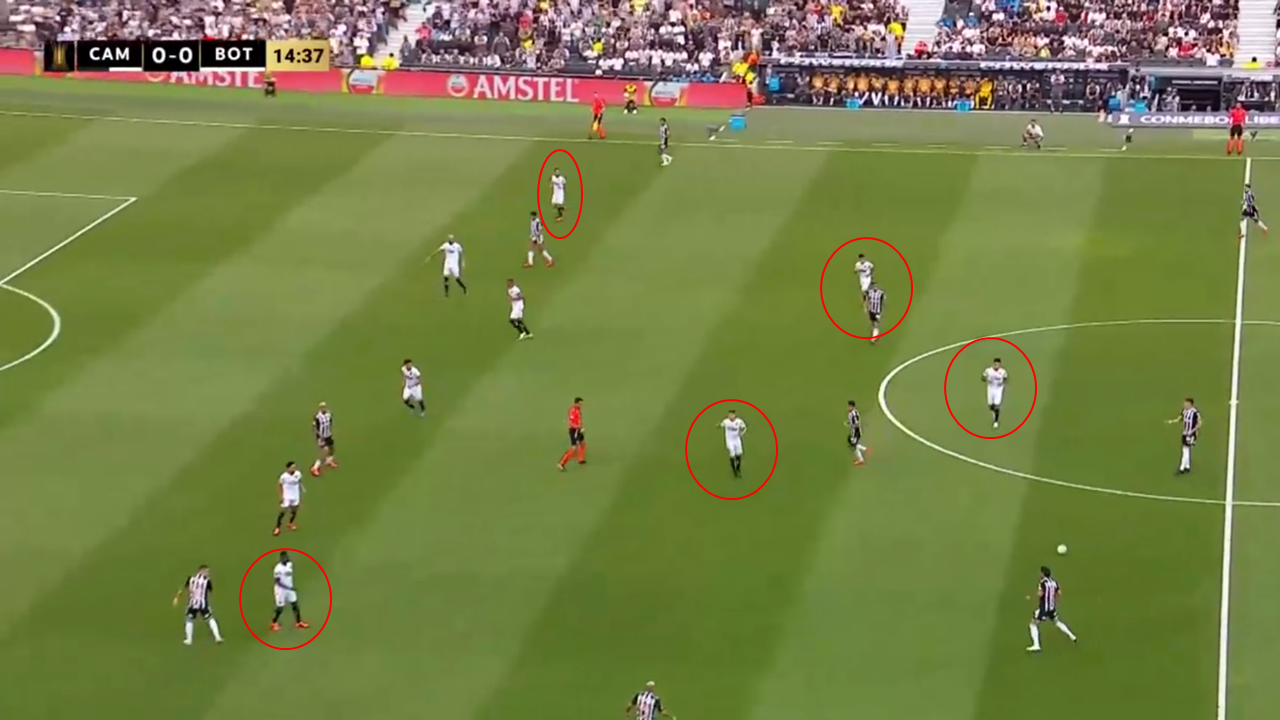
However, there were occasions when both wingers took up positions in the backline.
This is while Striker Igor Jesus would make up a midfield three with Savarino and Freitas to block off the middle of the pitch.
This did work, yet with the game at 0-0, Botafogo had to show courage and try to put their opponents under pressure if they were to harbour any hope of winning the match.
When the ball was either cleared or passed back towards the Atlético Mineiro goal, the midfielders would spring into life and try their best to put the Minerio defenders under pressure.
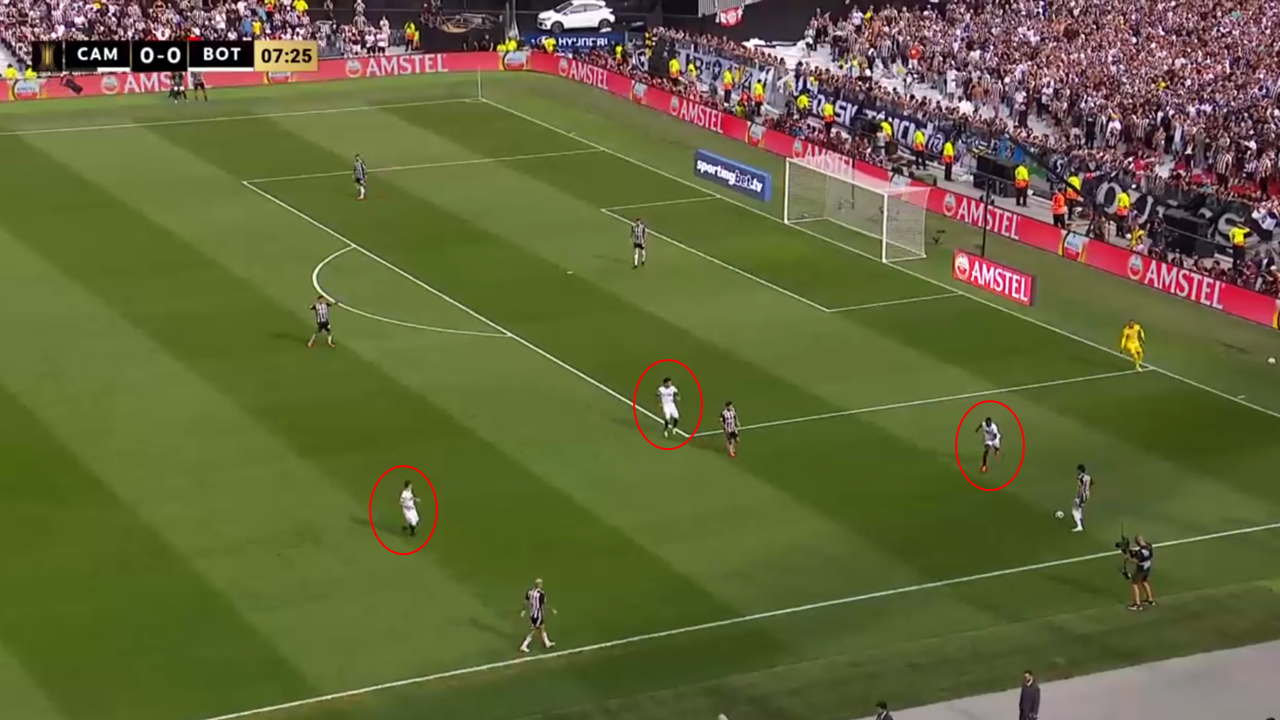
In this example, we see how Luis Henrique has covered a significant amount of ground to put pressure on the ball.
He’s joined by teammates Savarino and Vitinho, who help squeeze the pitch.
This bold move showed how Botafogo weren’t going to lie down and accept defeat.
A Lack Of Ideas
Logically, Mineiro should have been buoyed by their opponents going down to ten men.
They initially looked threatening, yet after the first ten minutes, their inability to deliver quality crosses, play at a high tempo, and create dangerous attacks led to Atlético Mineiro’s ineffectiveness in the first half.
One avenue that they often explored was shooting from distance.
Having skipper Hulk in their ranks increases the likelihood of being successful from these long-range efforts.
Yet when they had a numerical advantage, they failed to get into areas that would really hurt Minerio.
The same could be seen from when they were delivering balls into the box.
Minerio played the vast majority of their crosses from the left flank.
Yet they were often from particularly deep positions.
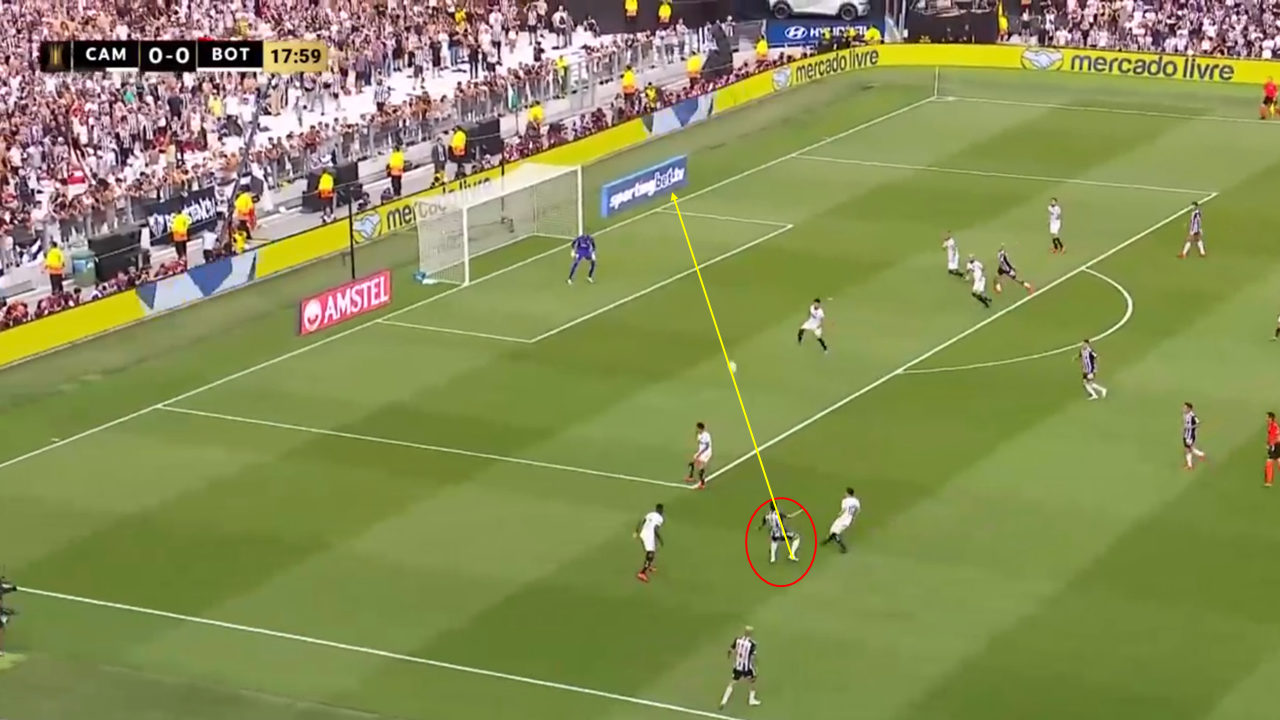
Here, an awful delivery is put into the box which heads out of play.
Atlético Mineiro Crossing Zones Map
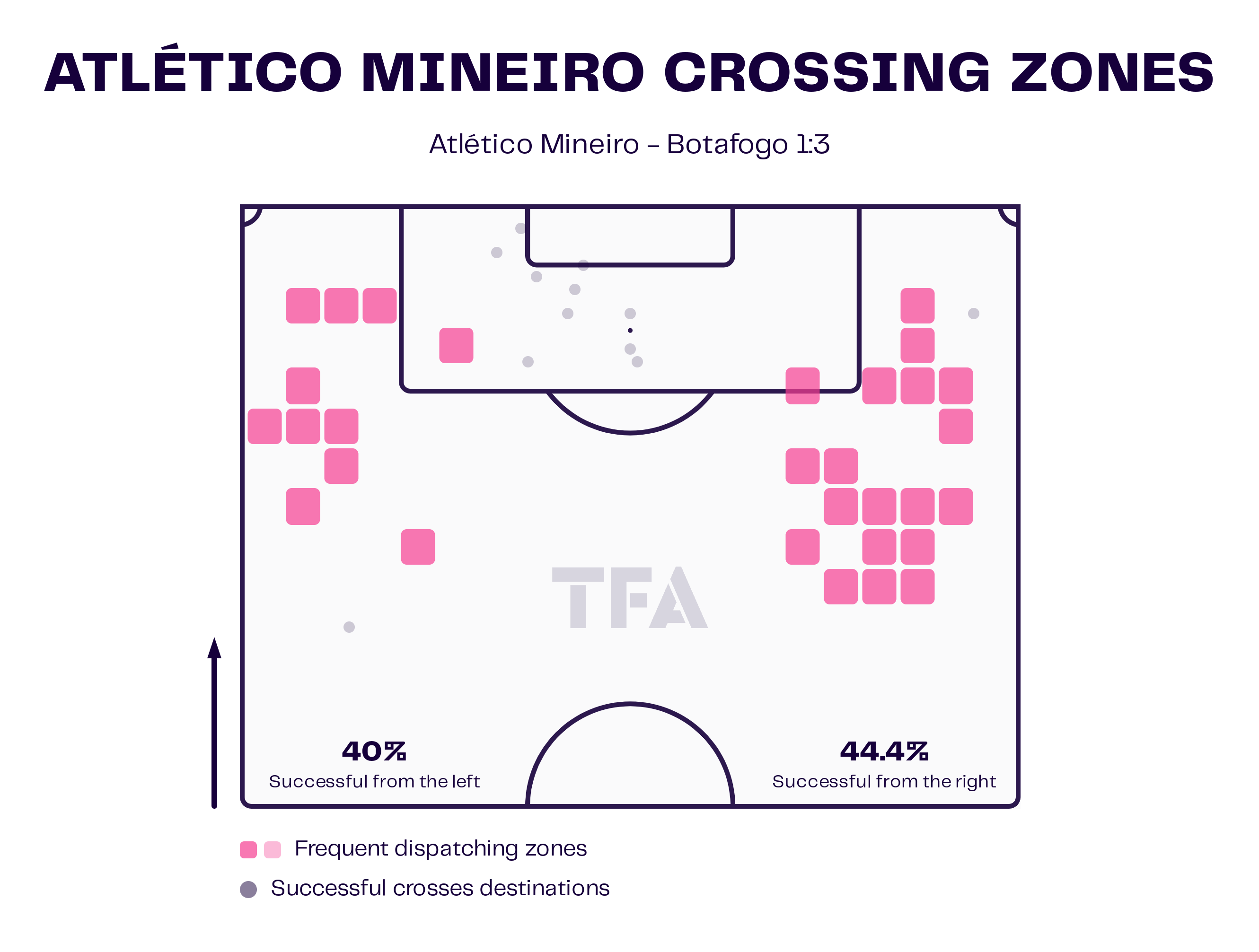
As seen from the areas where they dispatched their crosses, they came from deep positions.
This played right into Botafogo’s hands, as they were already set up to deal with these types of crosses.
Atlético Mineiro lacked dynamic runs that would provide them with the opportunities to cross from more dangerous areas.
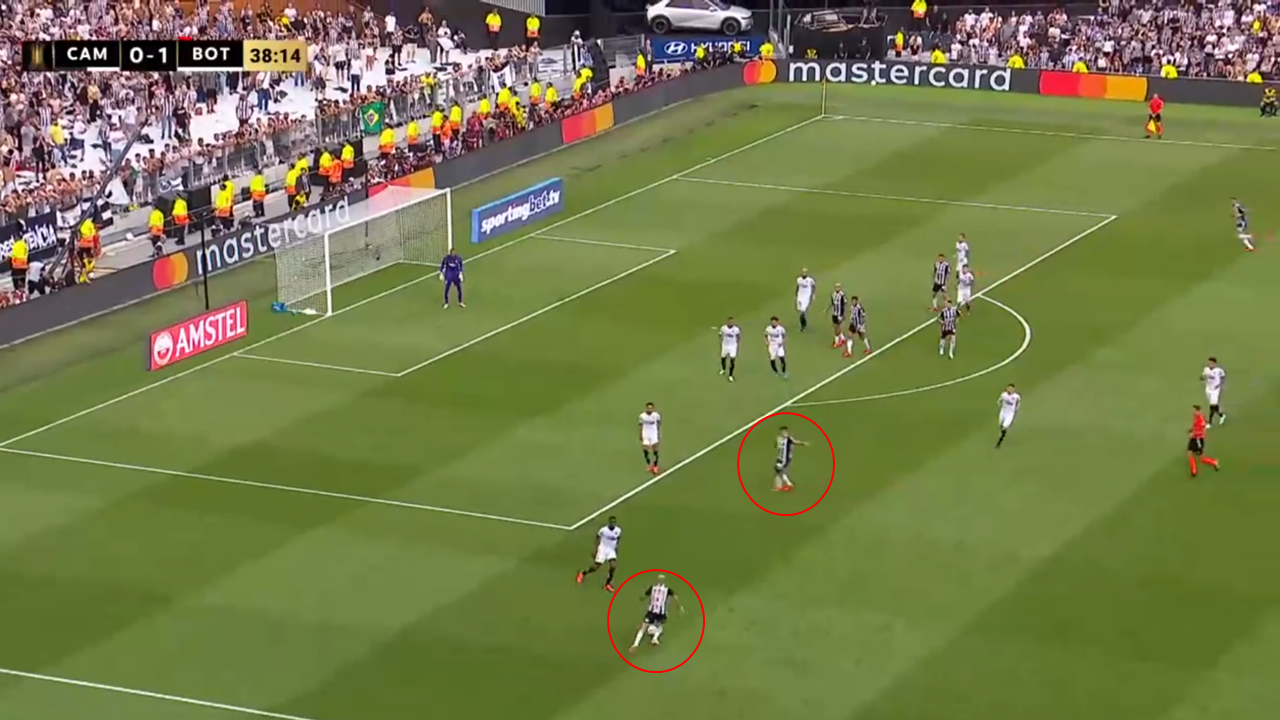
In this situation, Arana has the ball at his feet; he’s supported by Franco.
Neither player plays with directness or looks to penetrate through a forward run or combination play.
The ball is eventually played backwards.
Willing To Take Risks
As previously highlighted, Botafogo needed to take risks if they were going to win the match.
This was seen during the rare occasions they advanced into the final third.
When Botafogo’s first goal came, it was a result of flooding the box.
This led to Luis Henrique being in the right place and at the right time as he thundered the ball home for the opening goal.
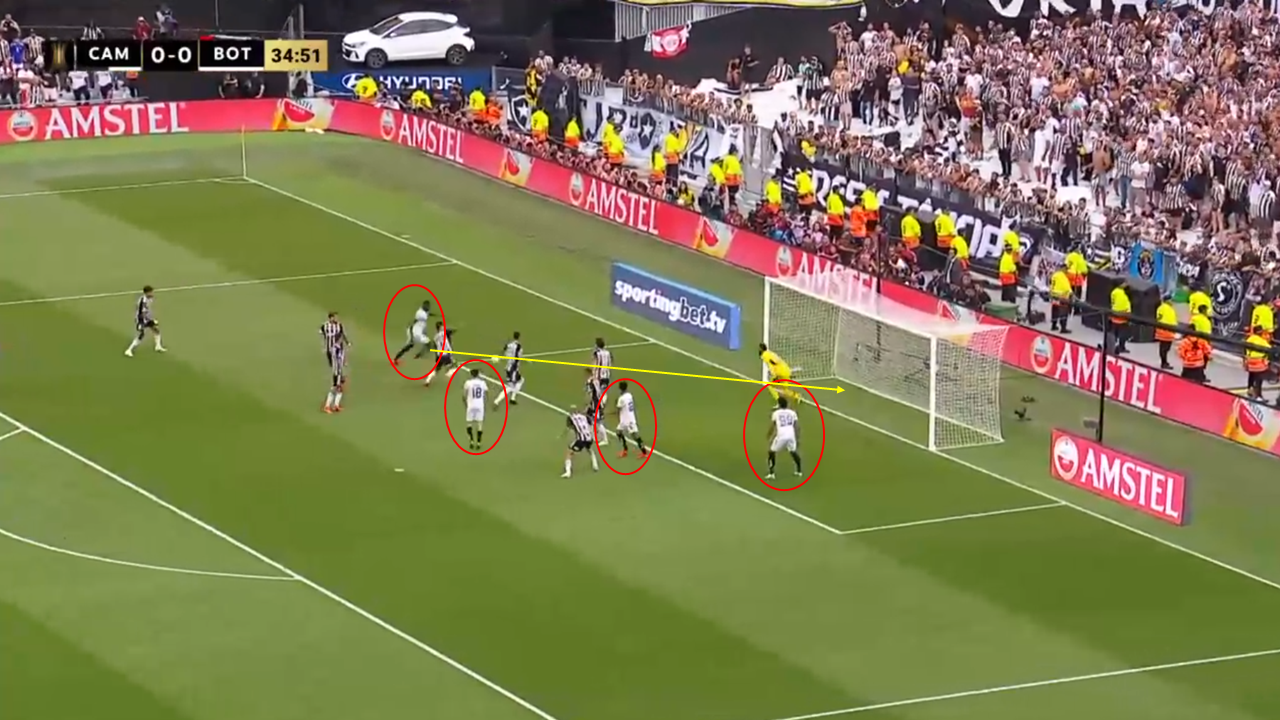
As the ball is crossed, you can see that Botafogo have four players in the box.
This gave them the chance they needed to score the crucial first goal.

Botofogo also took a degree of risk in their defensive set-up during the phase that led to their scoring.
They left themselves 2v2 at the back, meaning if Atlético Mineiro broke with pace and could find their forwards quickly, they wouldn’t have the normal numerical advantage most teams usually try to maintain in these situations.
However, the risk paid off.
Botafogo doubled their lead before the end of the half, meaning serious changes would be needed for Atlético Mineiro to get back into the game.
A Change In Attack
Drastic measures were taken at half-time by manager Gabriel Milito.
He made three substitutions, bringing on Mariano, Bernard and Eduardo Vargas.
The introduction of the former Everton man, Bernard, seemed to make the greatest impact.
The diminutive playmaker showed a level of intensity that hadn’t been seen in the first half.
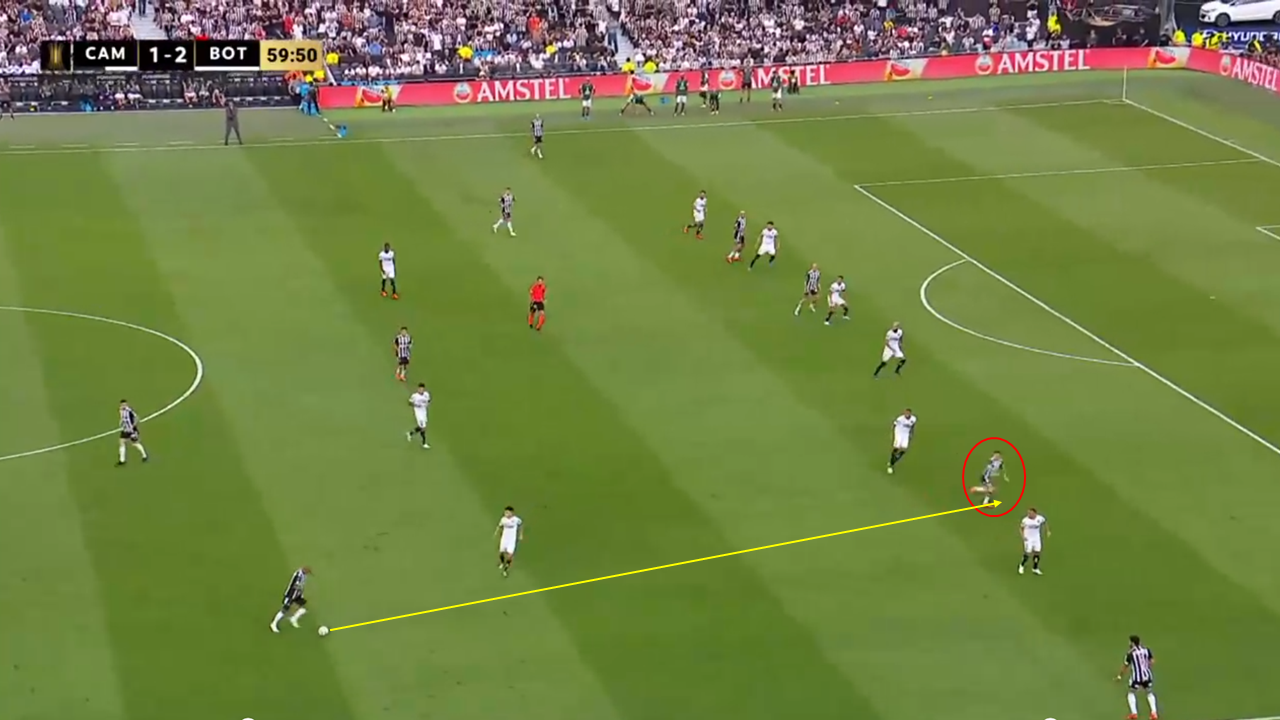
In this example, Mineiro’s attackers have taken up advanced positions in the hope that they can create gaps and stretch the backline of the packed Botafogo defence.
Bernard shows a willingness to make a penetrating run, which almost saw him break through on goal.
However, Minerio drew one back through a set piece.
The veteran Chilean forward Eduardo Vargas took advantage of Botafogo’s zonal marking system.
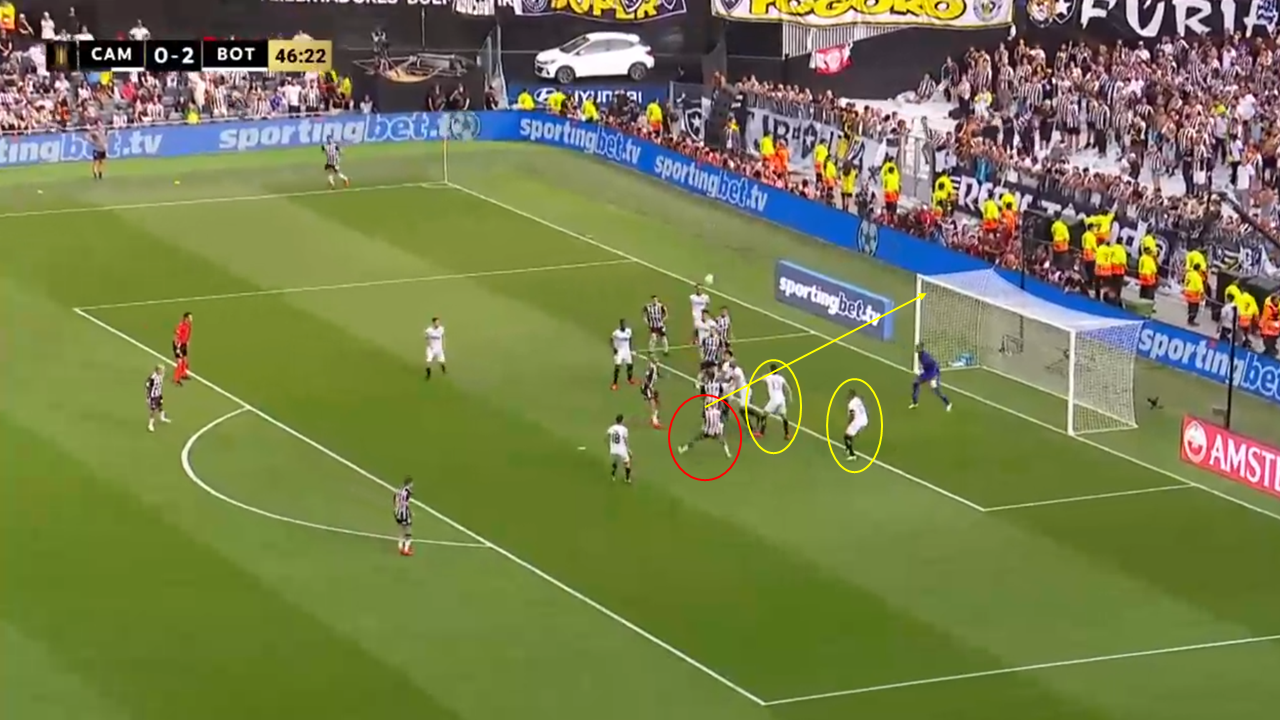
As highlighted above, Vargas had acres of space.
Botafogo had elected to have their most aerial proficient players take up positions on the edge of the six-yard box.
As an out swinging delivery by Hulk makes its way towards Vargas, none of Botafogo’s defenders takes the initiative to leave their area to attack the ball, giving Vargas an easy chance.
The Same Old Story
Bernard’s intelligent movement was causing some serious issues for a tired Botafogo.
His runs were opening up space for his teammates to exploit.
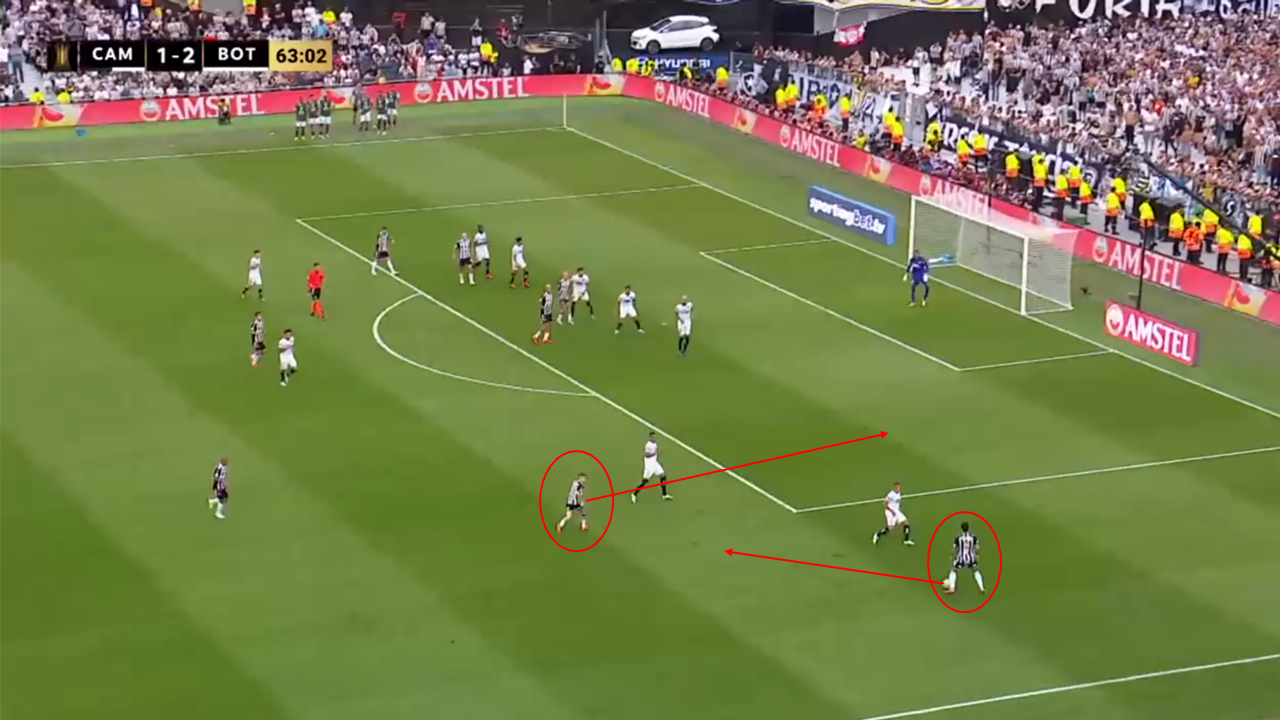
In this example, Bernard makes a diagonal run that takes a defender away from the middle of the pitch.
This leaves space for Hulk to dribble inside and get his shot off on goal, testing the goalkeeper.
However, despite these positive runs, there were far too many occasions when they weren’t used effectively.
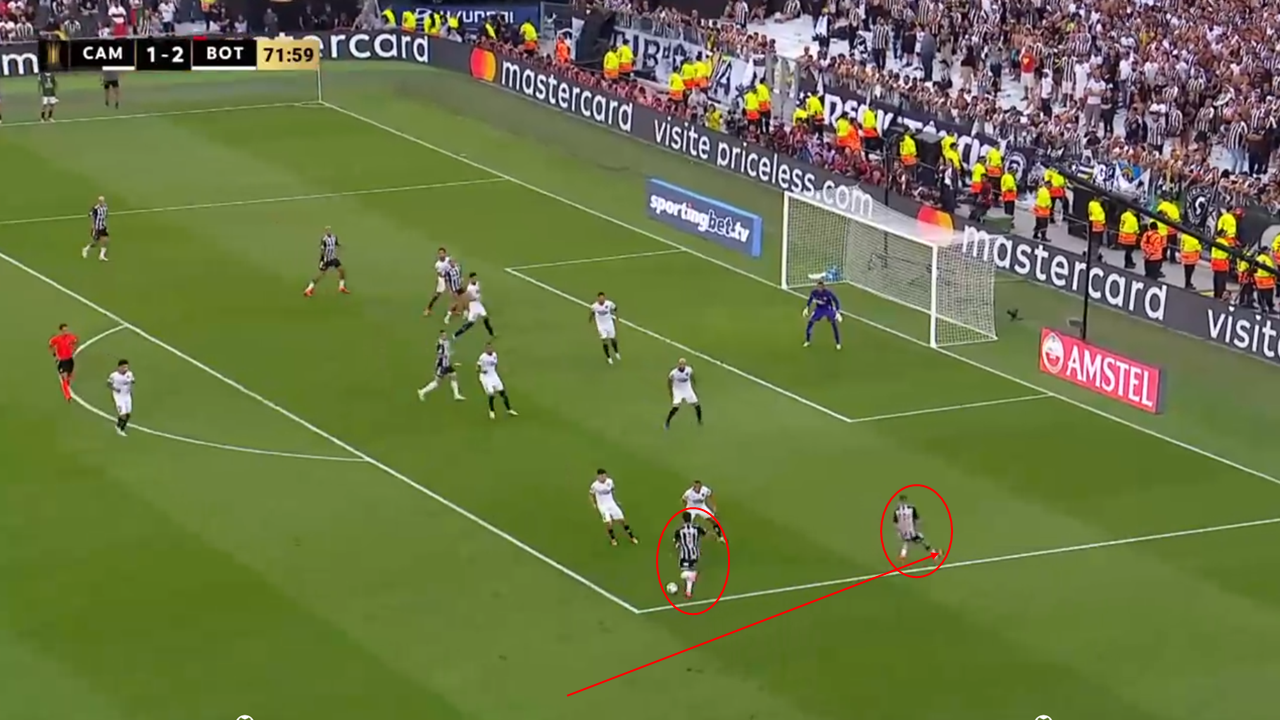
Again, Bernard makes a great run, overlapping Hulk.
If the forward decides to pass the ball to his teammate, he will be in a prime position to deliver a dangerous cross.
However, Hulk’s one-dimensional play sees him cut inside and again shoot from a difficult angle in a crowded penalty area.
Conclusion
Atlético Mineiro’s fans will be shaken by their team’s awful performance in a game in which they had a numerical advantage.
Their lack of intensity and creativity was unacceptable.
However, Botafogo’s performance has to go down as one of the greatest in Copa Libertadores history.
To be able to win a game in which they were down to 10 men from the first minute is absolutely remarkable.
To do it in a final where they had the pressure of making history proves that it was even more impressive.
It will be a blueprint for teams on how to grab victory from the jaws of defeat after facing a red card.

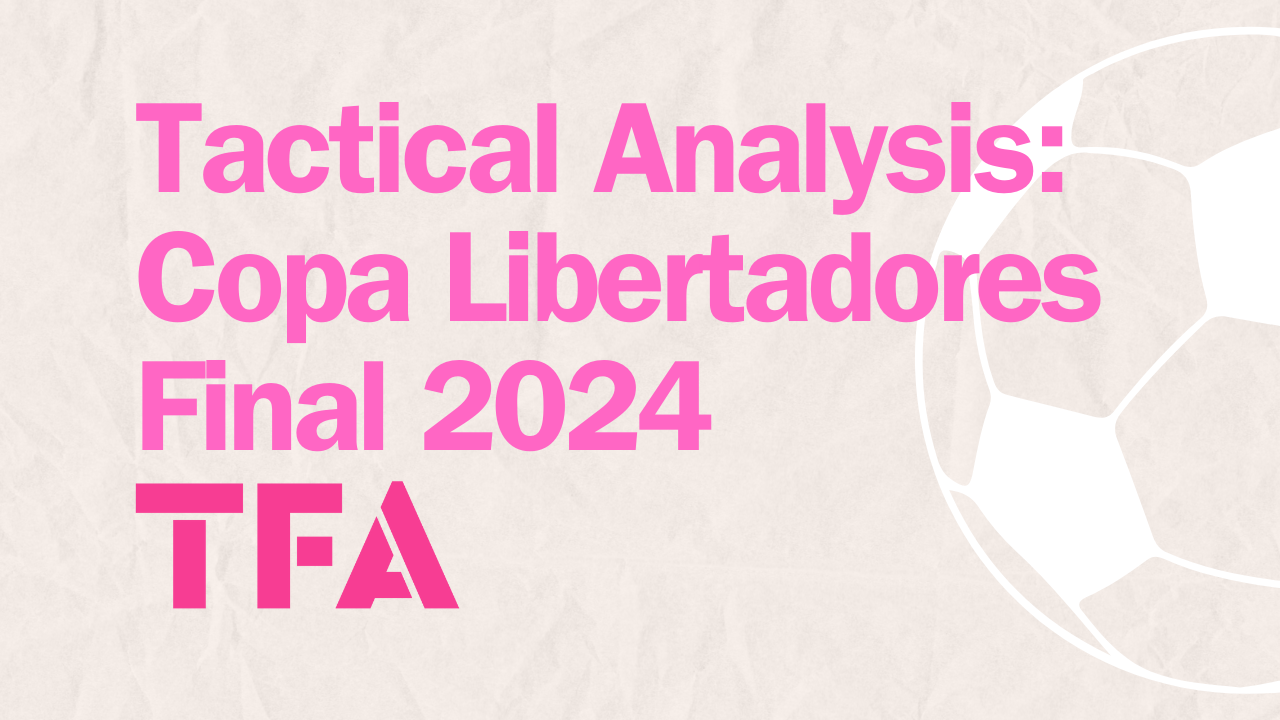



Comments